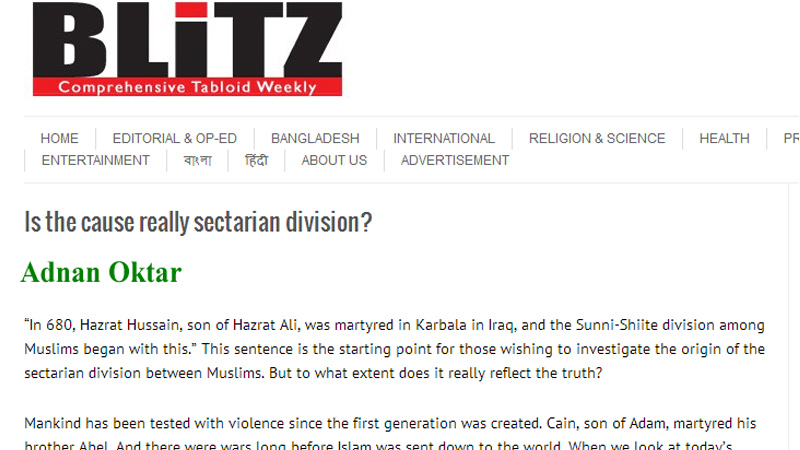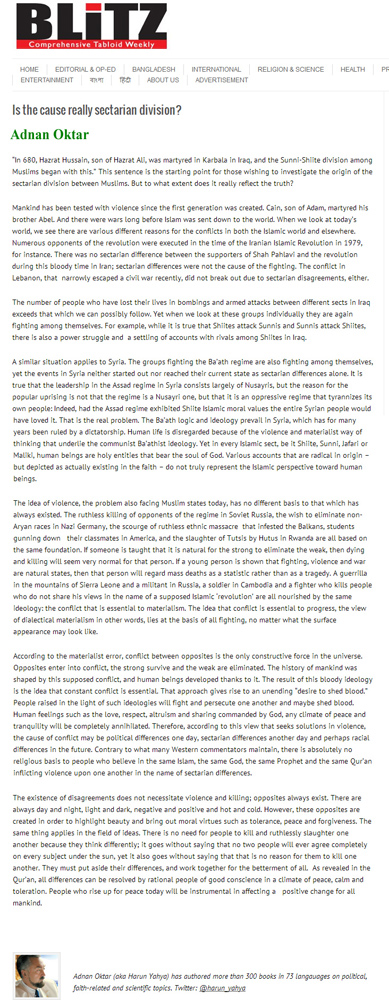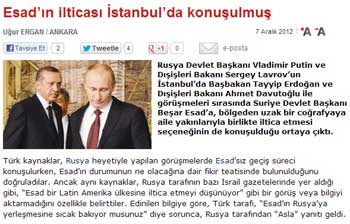Bigotry: The Dark Danger
Is the cause really sectarian division?


“In 680, Hazrat Hussain, son of Hazrat Ali, was martyred in Karbala in Iraq, and the Sunni-Shiite division among Muslims began with this.” This sentence is the starting point for those wishing to investigate the origin of the sectarian division between Muslims. But to what extent does it really reflect the truth?
Mankind has been tested with violence since the first generation was created. Cain, son of Adam, martyred his brother Abel. And there were wars long before Islam was sent down to the world. When we look at today’s world, we see there are various different reasons for the conflicts in both the Islamic world and elsewhere. Numerous opponents of the revolution were executed in the time of the Iranian Islamic Revolution in 1979, for instance. There was no sectarian difference between the supporters of Shah Pahlavi and the revolution during this bloody time in Iran; sectarian differences were not the cause of the fighting. The conflict in Lebanon, that narrowly escaped a civil war recently, did not break out due to sectarian disagreements, either.
The number of people who have lost their lives in bombings and armed attacks between different sects in Iraq exceeds that which we can possibly follow. Yet when we look at these groups individually they are again fighting among themselves. For example, while it is true that Shiites attack Sunnis and Sunnis attack Shiites, there is also a power struggle and a settling of accounts with rivals among Shiites in Iraq.
A similar situation applies to Syria. The groups fighting the Ba’ath regime are also fighting among themselves, yet the events in Syria neither started out nor reached their current state as sectarian differences alone. It is true that the leadership in the Assad regime in Syria consists largely of Nusayris, but the reason for the popular uprising is not that the regime is a Nusayri one, but that it is an oppressive regime that tyrannizes its own people: Indeed, had the Assad regime exhibited Shiite Islamic moral values the entire Syrian people would have loved it. That is the real problem. The Ba’ath logic and ideology prevail in Syria, which has for many years been ruled by a dictatorship. Human life is disregarded because of the violence and materialist way of thinking that underlie the communist Ba’athist ideology. Yet in every Islamic sect, be it Shiite, Sunni, Jafari or Maliki, human beings are holy entities that bear the soul of God. Various accounts that are radical in origin - but depicted as actually existing in the faith - do not truly represent the Islamic perspective toward human beings.
The idea of violence, the problem also facing Muslim states today, has no different basis to that which has always existed. The ruthless killing of opponents of the regime in Soviet Russia, the wish to eliminate non-Aryan races in Nazi Germany, the scourge of ruthless ethnic massacre that infested the Balkans, students gunning down their classmates in America, and the slaughter of Tutsis by Hutus in Rwanda are all based on the same foundation. If someone is taught that it is natural for the strong to eliminate the weak, then dying and killing will seem very normal for that person. If a young person is shown that fighting, violence and war are natural states, then that person will regard mass deaths as a statistic rather than as a tragedy. A guerrilla in the mountains of Sierra Leone and a militant in Russia, a soldier in Cambodia and a fighter who kills people who do not share his views in the name of a supposed Islamic ‘revolution’ are all nourished by the same ideology: the conflict that is essential to materialism. The idea that conflict is essential to progress, the view of dialectical materialism in other words, lies at the basis of all fighting, no matter what the surface appearance may look like.
According to the materialist error, conflict between opposites is the only constructive force in the universe. Opposites enter into conflict, the strong survive and the weak are eliminated. The history of mankind was shaped by this supposed conflict, and human beings developed thanks to it. The result of this bloody ideology is the idea that constant conflict is essential. That approach gives rise to an unending “desire to shed blood.” People raised in the light of such ideologies will fight and persecute one another and maybe shed blood. Human feelings such as the love, respect, altruism and sharing commanded by God, any climate of peace and tranquility will be completely annihilated. Therefore, according to this view that seeks solutions in violence, the cause of conflict may be political differences one day, sectarian differences another day and perhaps racial differences in the future. Contrary to what many Western commentators maintain, there is absolutely no religious basis to people who believe in the same Islam, the same God, the same prophet and the same Qur’an inflicting violence upon one another in the name of sectarian differences.
The existence of disagreements does not necessitate violence and killing; opposites always exist. There are always day and night, light and dark, negative and positive and hot and cold. However, these opposites are created in order to highlight beauty and bring out moral virtues such as tolerance, peace and forgiveness. The same thing applies in the field of ideas. There is no need for people to kill and ruthlessly slaughter one another because they think differently; it goes without saying that no two people will ever agree completely on every subject under the sun, yet it also goes without saying that that is no reason for them to kill one another. They must put aside their differences, and work together for the betterment of all. As revealed in the Qur’an, all differences can be resolved by rational people of good conscience in a climate of peace, calm and toleration. People who rise up for peace today will be instrumental in affecting a positive change for all mankind.
Adnan Oktar's article on Blitz:
http://www.weeklyblitz.net/2014/02/cause-really-sectarian-division/
2014-02-25 21:10:58







